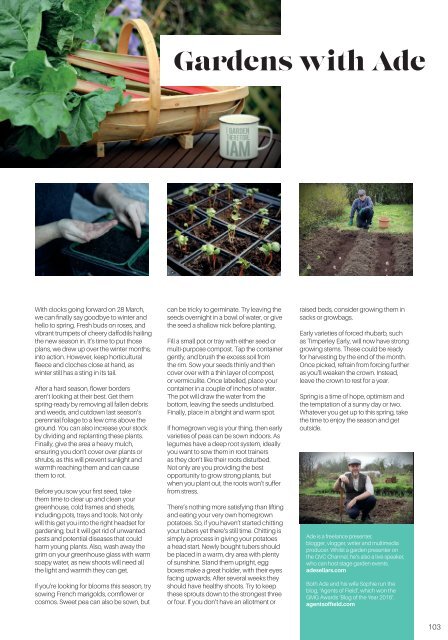Eastlife Spring 2021
This is our fourth issue during the pandemic. Fourth! I can’t quite believe it. Like many other businesses we have learned to adapt. I am no longer flustered when events are cancelled at the last moment before print, it has become the norm.
This is our fourth issue during the pandemic. Fourth! I can’t quite believe it. Like many other businesses we have learned to adapt. I am no longer flustered when events are cancelled at the last moment before print, it has become the norm.
Create successful ePaper yourself
Turn your PDF publications into a flip-book with our unique Google optimized e-Paper software.
Gardens with Ade<br />
With clocks going forward on 28 March,<br />
we can finally say goodbye to winter and<br />
hello to spring. Fresh buds on roses, and<br />
vibrant trumpets of cheery daffodils hailing<br />
the new season in. It’s time to put those<br />
plans, we drew up over the winter months,<br />
into action. However, keep horticultural<br />
fleece and cloches close at hand, as<br />
winter still has a sting in its tail.<br />
After a hard season, flower borders<br />
aren’t looking at their best. Get them<br />
spring-ready by removing all fallen debris<br />
and weeds, and cutdown last season’s<br />
perennial foliage to a few cms above the<br />
ground. You can also increase your stock<br />
by dividing and replanting these plants.<br />
Finally, give the area a heavy mulch,<br />
ensuring you don’t cover over plants or<br />
shrubs, as this will prevent sunlight and<br />
warmth reaching them and can cause<br />
them to rot.<br />
Before you sow your first seed, take<br />
them time to clear up and clean your<br />
greenhouse, cold frames and sheds,<br />
including pots, trays and tools. Not only<br />
will this get you into the right headset for<br />
gardening, but it will get rid of unwanted<br />
pests and potential diseases that could<br />
harm young plants. Also, wash away the<br />
grim on your greenhouse glass with warm<br />
soapy water, as new shoots will need all<br />
the light and warmth they can get.<br />
If you’re looking for blooms this season, try<br />
sowing French marigolds, cornflower or<br />
cosmos. Sweet pea can also be sown, but<br />
can be tricky to germinate. Try leaving the<br />
seeds overnight in a bowl of water, or give<br />
the seed a shallow nick before planting.<br />
Fill a small pot or tray with either seed or<br />
multi-purpose compost. Tap the container<br />
gently, and brush the excess soil from<br />
the rim. Sow your seeds thinly and then<br />
cover over with a thin layer of compost,<br />
or vermiculite. Once labelled, place your<br />
container in a couple of inches of water.<br />
The pot will draw the water from the<br />
bottom, leaving the seeds undisturbed.<br />
Finally, place in a bright and warm spot.<br />
If homegrown veg is your thing, then early<br />
varieties of peas can be sown indoors. As<br />
legumes have a deep root system, ideally<br />
you want to sow them in root trainers<br />
as they don’t like their roots disturbed.<br />
Not only are you providing the best<br />
opportunity to grow strong plants, but<br />
when you plant out, the roots won’t suffer<br />
from stress.<br />
There’s nothing more satisfying than lifting<br />
and eating your very own homegrown<br />
potatoes. So, if you haven’t started chitting<br />
your tubers yet there’s still time. Chitting is<br />
simply a process in giving your potatoes<br />
a head start. Newly bought tubers should<br />
be placed in a warm, dry area with plenty<br />
of sunshine. Stand them upright, egg<br />
boxes make a great holder, with their eyes<br />
facing upwards. After several weeks they<br />
should have healthy shoots. Try to keep<br />
these sprouts down to the strongest three<br />
or four. If you don’t have an allotment or<br />
raised beds, consider growing them in<br />
sacks or growbags.<br />
Early varieties of forced rhubarb, such<br />
as Timperley Early, will now have strong<br />
growing stems. These could be ready<br />
for harvesting by the end of the month.<br />
Once picked, refrain from forcing further<br />
as you’ll weaken the crown. Instead,<br />
leave the crown to rest for a year.<br />
<strong>Spring</strong> is a time of hope, optimism and<br />
the temptation of a sunny day or two.<br />
Whatever you get up to this spring, take<br />
the time to enjoy the season and get<br />
outside.<br />
Ade is a freelance presenter,<br />
blogger, vlogger, writer and multimedia<br />
producer. Whilst a garden presenter on<br />
the QVC Channel, he’s also a live speaker,<br />
who can host stage garden events.<br />
adesellars.com<br />
Both Ade and his wife Sophie run the<br />
blog, ‘Agents of Field’, which won the<br />
GMG Awards ‘Blog of the Year 2016’.<br />
agentsoffield.com<br />
103
















